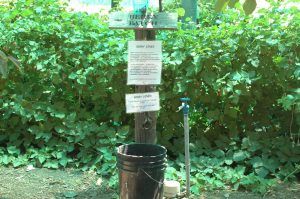Growing and Making Olallieberry Pie
Berries bring memories of summer days with berry juice on fingers and faces. Using a friend’s recipe (handed down from mother to mother) and my own olallieberries, we made a fabulous pie on the 4th of July to share with friends!
Olallieberry (pronounced oh-la-leh) is a cross between a loganberry and a youngberry (a classic blackberry and a red raspberry) first developed in 1949 at Oregon State University. Olallie is a Native American word meaning ‘berry”.
Four years ago, a friend gave me cuttings (clones) from her vines, passed down from her father, to start my berry garden. You can get bareroot olallieberry vines if you do not have such a generous source. In the spring, cut the tops of the canes back to six inches and plant in a sunny location 2½ feet apart in zones 7-9. Canes need a trellis to grow. We staked a 15-foot row with three horizontal rows of wire to train the vines using horticultural green tape. We used bailing wire, but clothesline works also. We started with four plants. During the first season, train the canes to sprawl over the trellis. Plants go dormant in winter; the next January cut off all but six canes from each plant and train them to your trellis.
Water once a week to get them established and continue through the summer. Fertilize plants the first year in mid-summer, and in each succeeding year apply fertilizer in early spring when foliage growth begins and again in mid-summer.
Berry canes are biennial, meaning a cane grows the first year and puts out laterals (branches). They produce berries the second year. Train your canes the first year, cut the laterals back to 20 inches in the fall, and produce lovely berries the next year in early summer.
After harvesting berries, you’ll need to prune. Some of us are pruning-challenged, but these are easy. Fruit-producing canes should be cut back to the ground. New canes are the ones that will produce the following year. They can now be trained on the trellis as they start to produce laterals. Cut laterals back to 20 inches.
We net our berry vines just as the fruit starts to turn red to thwart flying fruit thieves (birds). I also attach bird flashing to warn them away from getting caught in the netting. Our harvest starts in early July (at 2700’ elevation) and lasts about three weeks.
Now for the pie:
You’ll need about 5 cups of berries, 1 ¼ cups sugar, 2 Tbls cornstarch, 2 Tbls tapioca. Mix together, put into a large pie crust (in a pie pan of course) and top with second crust. Bake in a preheated 450-degree oven for 10 minutes; reduce heat to 350 for 50 minutes. Olallieberries make an amazing pie that will astound your family and friends and continue year after year. (Thank you, Linda and your mother for the gift of this recipe and the friendship and fun!)
Nancy Bliss is a University of California Cooperative Extension Master Gardener of Tuolumne County.

